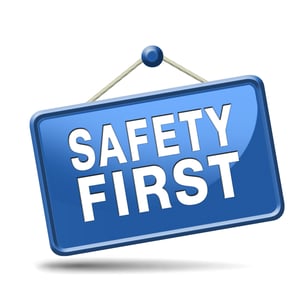Fume hoods are one of the most important pieces in a laboratory. Not used correctly, however, and they can be one of the most dangerous pieces.
A fume hood serves as a physical barrier between the employee and harmful fumes, fires, explosions and spills that may result from handling chemicals or conducting experiments.
Although fume hoods serve as a critical safety component in a lab, operators must follow strict procedures to ensure accidents do not occur. Here are five golden rules of fume hood lab safety to follow:
1. Perform Safety Measures BEFORE Using A Fume Hood
 Before using the fume hood, there are several steps you should take to ensure the fume hood is in top working order and that there are no outside influences that could disrupt its operation … or worse, create a fire or explosion hazard.
Before using the fume hood, there are several steps you should take to ensure the fume hood is in top working order and that there are no outside influences that could disrupt its operation … or worse, create a fire or explosion hazard.
A checklist can help accomplish this and ensure each technician follows the same procedures prior to use. Items that should be on a pre-use checklist include the following:
- Ensure the hood sash is opened to a proper height. If the sash is too high, there is not enough of a barrier between the user and the chemicals to provide protection. The proper height is usually indicated by a set of arrows located on the frame.
- Check the air gauge. Double check that it shows that the air flow is within the required range.
- Ensure the exhaust fan is working. This is a critical component of the fume hood. Determining whether hazardous fumes can escape includes checking the baffles. These are the movable partitions that create openings in the back of the hood and keep airflow uniform.
- Double check there are no spark sources nearby. Items like electrical receptacles and sources of static electricity can cause a spark, and a subsequent fire or explosion.
- Check the air filters. Clean filters are important because they remove hazardous fumes and particles. They should never be clogged.
2. Always Think Safety During Use
When using a fume hood, one of the most important golden rules is to keep safety a high priority from start to finish.
For example, always have eye protection on hand and make sure all users are wearing it. Even when the sash is in place, users should still wear eye protection when handling chemicals inside the fume hood.
Double check when using the hood that there is limited motion around and in front of the hood. Excess movement can cause the fume hood to vibrate and disrupt airflow.
Even though checking to make sure the baffles are not blocked is important to do before using the fume hood, it is also important to keep checking that air can flow into and out of the hood when using it.
Finally, when using a fume hood, keep any materials you are working with away from the sash. In fact, all materials should be at least 6 inches from the sash opening inside of the hood.
3. Avoid Storing Chemicals In A Fume Hood
Although you may be finished with the fume hood, a golden rule is to never be finished with safety. One of the most important safety precautions to remember is to never store chemicals in the hood.
Chemicals should instead be stored in industrial cabinets equipped to hold hazardous chemicals. While chemicals should not be stored in the fume hood, large equipment can as long as it is on top of blocks, which allows air flow under the equipment.
4. Make Sure Employees Are Up To Date On Training
 Laboratory facilities that use a fume hood should always make sure their employees are up to date on the latest safety training.
Laboratory facilities that use a fume hood should always make sure their employees are up to date on the latest safety training.
This is especially true in large facilities where employees may come and go. Anyone new should undergo a full training program on proper fume hood operating procedures. All employees should also get regular refresher courses, as well as be notified if any procedures change, if any new chemicals are introduced under the hood or new equipment is installed.
5. Have A Contingency Plan In Place
Even with all the proper safety precautions put into place, accidents can occur for any number of reasons, whether it’s safety procedures not being followed, insufficient supervision or inadequate training.
It’s important to know what to do if one does occur. Having a contingency plan in place can help your facility be prepared to act quickly … and to know what to do afterward.
Here are 5 steps that should be part of a contingency plan:
- Respond to the accident first. Put out any fires, contain any spills, evacuate the area if necessary, attend to the injured and contact emergency services.
- Investigate the cause. This means beginning the investigation right away. This will prevent important data from being lost and witnesses from forgetting important details.
- Prepare a root cause analysis. This is a process used to identify the primary source of a problem. In the case of a fume hood accident, an analysis may include possible causes that led to the accident, what sequence of events led up to it, and what conditions allowed the accident to occur. You will also want to identify any communication challenges leading up to the accident and responding to it. Report this information to management.
- Fix the problem. Once the cause of the accident is determined, take any appropriate steps needed to ensure it does not happen again. This may include developing a plan of action to resolve any issues that may have caused the accident.
- Test new procedures. Any new safety measures put into place must be monitored and tested to ensure that they will result in a safer workspace.
A fume hood is a state-of-the-art piece of equipment. With any piece of lab equipment, proper use and following all safety procedures is key to ensuring that the equipment operates as intended and employees are safe.


